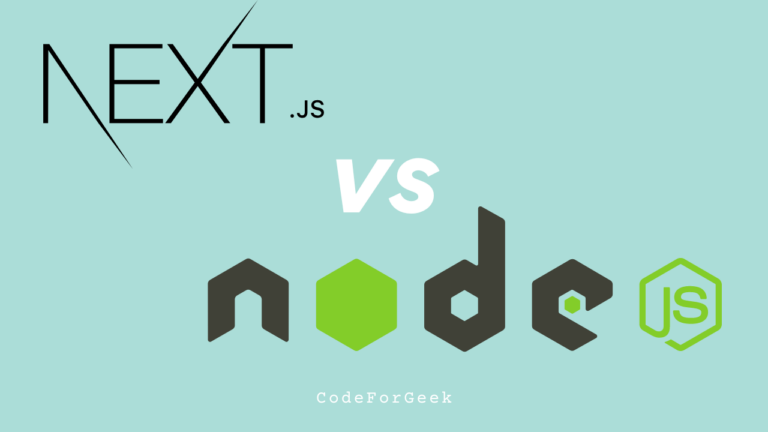As Node.js developers, we all love using Node.js for creating applications, however, it is always good to try new frameworks and technology that come up and if they are based on JavaScript it definitely catches our attention, Next.js is one of them. Next.js is a new growing framework that is becoming super popular nowadays and developers are using it in each of their JavaScript-based projects. So is it so good? or using native Node.js with third-party libraries is still a nice choice? Let’s compare in this article.
What is Node.js?
Node.js is a runtime environment built on the Chrome V8 engine that compiles JavaScript and converts it to native machine code, it has a non-blocking I/O paradigm making it perfect for developing real-time web apps, chat applications, and other applications that need real-time interaction.
Developers use JavaScript to write client-side code, now they can use the same language to write server-side code using Node.js. Using the same language for both the front end and the back end will result in high productivity and efficiency because there is no language switching needed.
What is Next.js?
Next.js is a new-age React framework used to create webpages quickly. It is famous for creating interactive and user-friendly interfaces. A big difference between Next.js and Node.js is that Next.js is designed to be used for client-side with server-side rendering whereas Node.js is designed to be used for writing server-side code only.
Next.js extends the functionality of Node.js by providing features such as built-in TypeScript support, middleware support, API support, enabling pre-rendering of pages at build time, server-side rendering, routing, automatic code splitting, etc.
Difference Between Node.js and Next.js
1. Performance
In terms of performance, we all know how good Node.js is. Node.js is popular for this, its non-blocking, event-driven architecture and V8 engine make it much faster than other languages. It can handle multiple concurrent connections simultaneously with less resources.
On the other hand, Next.js is built on top of Node.js with lots of optimisation like automatic code splitting, caching, etc that can make it better in terms of performance if we talk about server-side rendering (SSR) and static site generation (SSG). So it depends on the architecture and type of application building.
2. Ease of Use
Node.js itself doesn’t give much, we have to build the application from scratch, whether it is writing boilerplate code, setup and configuration, running servers or even creating mandatory files like package.json, you have to do all yours. It is a low-level runtime environment by which we can create anything with good skills but it is difficult for beginners.
Whereas Next.js is offering a lot of things. It is a high-level framework that simplifies coding with built-in routing, SSR, and SSG capabilities. With Next.js we can generate starting code, do setup quickly, and even deploy the application without any additional configuration. So Next.js is considered better in terms of ease of use.
3. Community Support
Community Support for both technologies is very good, but since Node.js is quite old and Next.js is very new, it’s obvious that the resources, documentation, and tutorials on Node.js are much greater in number. So community support in Node.js is considered better than Next.js.
4. Database Integration
In terms of database connectivity, both Node.js and Next.js can integrate with any database like MongoDB, MySQL, PostgreSQL, Redis or any other database.
5. Real-Time Applications
Node.js is best for creating real-time applications due to its event-driven architecture. We can also implement real-time features in Next.js but it’s mainly focused on static and server-rendered applications. So if you want to build real-time applications then Node.js is considered better than Next.js.
6. Use Case
Node.js is used for creating servers, APIs, microservices, and real-time applications whereas Next.js is used for creating web applications with React that need server-side rendering, static site generation or both.
7. Learning Curve
Node.js is a world itself, it is very huge and by using it you can create any type of application but its learning curve is quite complex as you need to learn a lot of things as Node.js is a low-level runtime environment so a lot of steps are required whereas Next.js is a high-level framework and it is super easy, especially for React developers. It simplifies the development process. It is easy to get started, setup and with lots of built-in features it makes everything beginner-friendly.
8. Companies Using Node.js and Next.js
Popular companies using Node.js are Netflix, PayPal, LinkedIn, Uber, eBay, Medium, Trello, and Walmart. On the other hand, companies using Next.js include Vercel, Twitch, Hulu, Nike, TikTok, Netflix (front-end), and GitHub.
Conclusion
In conclusion, choosing between Node.js and Next.js depends totally on the type of application you are building. Node.js is a JavaScript runtime environment with non-blocking, event-driven architecture and a V8 engine that offers high performance. It is a low-level runtime environment so the developer has to do the majority of things manually, like setup and configuration. It is best for creating servers, APIs, microservices, and real-time applications.
On the other hand, Next.js is built on top of Node.js which makes web development easy by providing many built-in features. It is a high-level framework that makes it easy to set up and has lots of built-in commands to get things done. It is best for creating modern web applications that require SSR and SSG.
If you are still comparing Node.js with other technologies, here are some more interesting comparisons for you:





